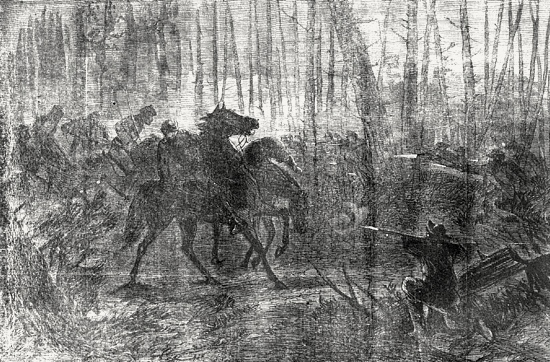Civil War: The Dahlgren Affair
As I hinted in my last column, the story of Kilpatrick’s Dahlgren’s gets quite a bit more interesting and is a topic of controversy even today. Conspiracy theorists, take note.

Earlier this month, we learned about the botched raid on Richmond led by two Union officers, General Hugh Judson Kilpatrick and Colonel Ulric Dahlgren. Their plan to assault the Confederate capital and free Union prisoners-of-war on Belle Isle was abandoned after a few days and resulted in Dahlgren’s death at the hand of Richmond’s home guard. As I hinted in my last column, the story didn’t end with Kilpatrick’s retreat and Dahlgren’s death. It gets quite a bit more interesting and is a topic of controversy even today. Conspiracy theorists, take note.
After Dahlgren was shot and killed by the Richmond home guard, a 13-year-old boy named William Littlepage discovered his body and searched his pockets for valuables. He found some documents that he then shared with his teacher Edward Halbach. Halbach, an officer in Richmond’s home guard, quickly realized what he had on his hands and promptly sent it up the chain of command until ultimately the documents reached the hands of President Jefferson Davis himself.
The documents contained detailed orders on how the raid and rescue operation was to be executed. However, amidst the other details, there was a section that would shock the Confederate government and reverberate through the entire Southern press. It read:
As we approach the city the party must take great care that they do not get ahead of the other party on the south side, and must conceal themselves and watch our movements. We will try and secure the bridge to the city, 1 mile below Belle Isle, and release the prisoners at the same time. If we do not succeed they must then dash down, and we will try and carry the bridge from each side. When necessary, the men must be filed through the woods and along the river bank. The bridges once secured, and the prisoners loose and over the river, the bridges will be secured and the city destroyed. The men must keep together and well in hand, and once in the city it must be destroyed and Jeff Davis and cabinet killed.
At the time, an order like this was not only considered outside the bounds of warfare, but an act of barbarism and terrorism. Once word spread of the discovered orders, it was met with outrage throughout the Confederacy. Confederate Gen. Robert E. Lee quickly dispatched a message to Union Gen. George Meade to inquire as to whether the orders were issued from a higher power or from Dahlgren himself. If it was Dahlgren, it could be written off as one overzealous man’s mistake, but if the orders came from the War Department, or worse, President Lincoln himself (as many believed), it would have changed the tone of the war entirely. Then there’s a third possibility: that the orders were forged by the Confederate government or sympathizers to drum up Southern outrage and aid their war effort.
Unfortunately, despite many scholars throwing around their opinions on the issue, we just don’t know for sure. Meade put Kilpatrick in charge of the investigation, who ultimately blamed Dahlgren, which was easy because the dead man is always easy to blame. Many, however, think Kilpatrick himself gave the orders. For many years after the incident, Dahlgren’s father publicly defended his son, questioning the authenticity of the papers and calling out what he thought was a misspelling of Dahlgren’s name in the photographs of the document that were made.
So, the best way for us to get to the bottom of the mystery is to take a look at the original document that was filed away in the Confederate War Department after the incident. Well, in April 1865, when (spoiler alert) the Union army took control of Richmond, a multitude of documents including the Dahlgren papers were sent north to Washington D.C. for safekeeping. Secretary of War Edwin Stanton specifically requested the Dahlgren papers be brought to him from the collection of Confederate documents…and then it disappeared from the historic record. It’s unknown if the documents made it to Stanton or if he lost them himself. Many speculate that Dahlgren’s orders ended up in Stanton’s fireplace to avoid any further scrutiny. So, we’ll never really know how much Stanton or Lincoln knew about Dahlgren’s mission, but it certainly feels like a bit of a cover up took place.
One of the great ironies of this incident, regardless of whether Lincoln was aware of the orders or approved them, is that they ultimately opened the door for the Confederate Secret Service to put plans into motion to kidnap him as a retaliatory measure. One of those Confederate conspirators was none other than the actor John Wilkes Booth, who would eventually go on to assassinate Lincoln in April 1865. I tend to have a hard time believing in stories that wrap up in a neat little historical bow like this one, with one assassination attempt begetting another. I’m sure the truth is a lot more complicated, but because it is lost to history, we’re left to put the pieces together ourselves–something conspiracy theorists get a real kick out of.
Whether it was a conspiracy to assassinate Jeff Davis and his cabinet or the misguided plan of an over-enthusiastic young colonel, it was another event in Richmond that changed the course of the war.
-
Recommend this
on Facebook -

Report an error
-

Subscribe to our
Weekly Digest




There are 2 reader comments. Read them.